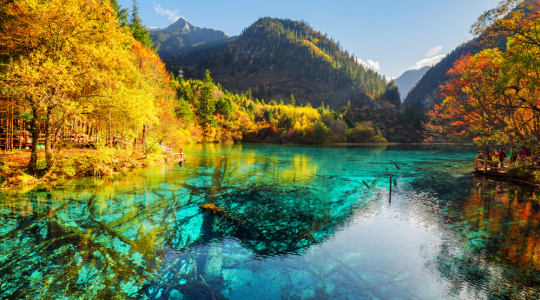
Jiuzhaigou is a scenic area located in the northwest of Sichuan Province, China. The name "Jiuzhaigou" means "Valley of Nine Villages" and refers to the nine Tibetan villages located in the area. It is known for its stunning natural scenery, including crystal clear lakes, cascading waterfalls, and colorful forests.
Jiuzhaigou is a UNESCO World Heritage Site and is considered one of China's most beautiful natural attractions. The area covers over 72,000 hectares and includes three main valleys: Rize Valley, Shuzheng Valley, and Zechawa Valley. These valleys are home to more than 100 lakes and over 17 waterfalls, as well as a wide variety of plants and animals.
One of the most iconic features of Jiuzhaigou is its turquoise-colored lakes, which are the result of the area's unique geological features. The lakes are fed by mineral-rich springs and are surrounded by colorful forests that change color with the seasons. In addition to the lakes, Jiuzhaigou is also home to several major waterfalls, including the Nuorilang Waterfall, which is one of the widest waterfalls in China.
Visitors to Jiuzhaigou can explore the area on foot or by shuttle bus, and there are a number of hiking trails that lead to some of the more remote areas of the park. There are also a number of cultural attractions in the area, including the Jiuzhaigou Folk Culture Museum and the Tibetan village of Shuzheng, where visitors can learn about traditional Tibetan culture and customs.
Explore Near Jiuzhaigou
Discover 1 attraction and 1 airport within 75km. Perfect for planning day trips, finding connecting flights, or discovering new destinations to explore during your visit.
Nearby Attractions & Places to Visit
1 destination within 51.2km from your location

Airports Near Jiuzhaigou
1 destination within 43.6km from your location
Cross-Border Adventures Near Jiuzhaigou
Discover cross-border adventures near Jiuzhaigou. Explore neighboring countries with similar attractions and extend your travel experience across borders.








And 8 more neighboring countries